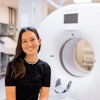
Our new informatics column explains why PACS has a crucial role to play in providing access to clinical information, and why radiologists must ensure vendors conform to the Cross-Enterprise Document Sharing for Imaging and Cross-Community Access for Imaging standards.
Radiology reports are opinions provided by radiologists when reviewing images. Opinions are based on three main factors: findings on the images, previous imaging availability for comparison, and clinical information provided on the request card or referral letter
The quality of images -- and thus, the ability to see pathology -- has improved with technological advances, particularly the move from planar imaging to cross-sectional and functional imaging, and the development of new multislice CT scanners and MRI systems. This has led to increased accuracy in radiology reports.
 Dr. Neelam Dugar is a consultant radiologist at Doncaster Royal Infirmary, U.K., and chair of the Royal College of Radiologists' Imaging Informatics Group.
Dr. Neelam Dugar is a consultant radiologist at Doncaster Royal Infirmary, U.K., and chair of the Royal College of Radiologists' Imaging Informatics Group.
Deployment of PACS has significantly improved the availability of previous imaging at the time of reporting. In the past, films could only be in one place at a time. Hence, radiologists often had to report images in the absence of previous images being available. Due to PACS, reporting radiologists always have access to previous stored images, which boosts the accuracy of reports.
However, the clinical information on a request card has remained the same, at least in the U.K. Many request cards provide three-letter abbreviations as the only clinical information. Radiologists are very aware that good clinical information often is key to better and more accurate reports.
For instance, access to information about a patient who has pyrexia with raised inflammatory markers may provide the crucial distinction between an inflamed lymph node in the neck versus a malignant node. In such cases, cancer multidisciplinary team meetings (MDTMs) provide a means of improving report accuracy and quality because images are discussed. Giving an opinion on available pathology and providing a good quality clinical history can make all the difference at MDTMs. It is well-recognized that second opinions should be recorded by radiologists following discussions at MDTMs, as these opinions often will be more accurate and precise with the additional knowledge gained at MDTMs.
As we move into next-generation PACS, we must look at how to obtain access to more clinical information to improve report quality, rather than simply relying on a sentence on the request card. Currently, radiology PACS is a data silo and is separate from the rest of the patient's clinical record. Next-generation PACS must address this important issue. Radiology images must be available alongside other medical images and documents such as pathology reports, lab results, and referral letters. PACS must also be able to display other forms of clinical information.
The globally emerging interoperability standard for patient-centric filing of medical images and documents is the Cross-Enterprise Document Sharing (XDS) standard, which forms part of the Integrating the Healthcare Enterprise (IHE). By adopting the XDS for Imaging (XDS-I) standard, radiology PACS can register images to an XDS registry. Similarly, radiology PACS will be able to display other medical images and documents.

If a CT scan displays an abnormal-looking pancreas, and if the radiologist knows blood amylase levels are above 1000, then a confident diagnosis of acute pancreatitis can be made. Similarly, access to tumor markers such as CA-125 and CEA can help in the reporting of oncology images. To improve the quality and accuracy of radiology reports in the future, access to patient-centric clinical information is vital.
Adoption of global standards like XDS-I by PACS vendors will depend on clinical users like radiologists insisting on these standards being written down in their procurement or replacement specifications. Radiologists should include the following statement in their PACS replacement or procurement: "Radiology PACS must be XDS-I source- and consumer-compliant." This will go a long way toward moving away from a data silo position, and it will help to ensure that our PACS become an integral part of the electronic patient record.
Patients' previous images often lie in other hospitals but are hugely important for providing an accurate radiology report. This is particularly true when there is centralization of cancer services, etc. Today the sharing of radiology images beyond the information governance boundaries often requires manual and cumbersome process like CDs, and DICOM push links between different PACS.
Another emerging standard from IHE is Cross-Community Access for Imaging (XCA-I), which allows secure image exchange beyond traditional information governance boundaries without the need for CDs, provided access and permissions are agreed between organizations such as cancer networks. XCA-I has recently gone into trial implementation within IHE. It is hoped by the end of the year it will be available for vendors to build into their products. Again, it is important that radiologists include XCA-I support within their specification.
The next-generation PACS holds promise for improving radiology report quality and accuracy by enabling access to other forms of clinical information. It will also allow for access to radiology images stored in neighboring hospitals at the time of reporting, provided legal/access and permission issues are agreed, thus improving access to previous images held elsewhere. However, it is important that radiologists ensure that PACS vendors conform to XDS-I and XCA-I standards of IHE when specifying for new or replacement radiology PACS.
Dr. Neelam Dugar is consultant radiologist at Doncaster Royal Infirmary, U.K., and chair of the Royal College of Radiologists' Imaging Informatics Group.
The comments and observations expressed herein do not necessarily reflect the opinions of AuntMinnieEurope.com, nor should they be construed as an endorsement or admonishment of any particular vendor, analyst, industry consultant, or consulting group.



















